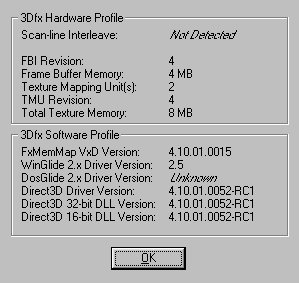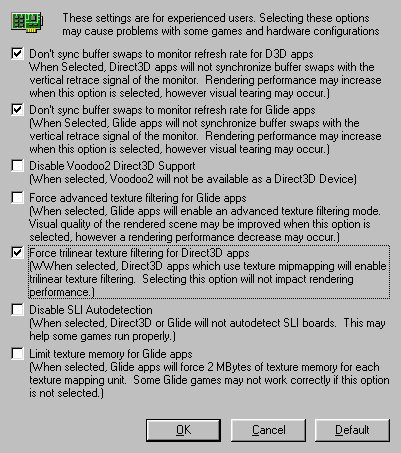Creative Labs 3D Blaster Voodoo2
Introduction
Creative won the race of which company will be first on the market with a Voodoo² 3D accelerator and after we've seen the performance of the pre-release Voodoo² card from Diamond, it's now time to check how well a final product will perform. The 3D Blaster Voodoo² comes with 12 MB of onboard memory, 4 MB frame buffer and 4 MB texture buffer for each of the two Texelfx2 units, making 12 MB altogether. This is 4 MB more than what Diamond is planning to put on their Monster 3D II card, which is only one of the reasons why Diamond and Creative didn't have anything better to do than throwing mud at each other in the press previous to the release date of the 3D Blaster Voodoo², with most of the weight on Diamond's side. Now, since Creative Labs started shipping their 12 MB Voodoo² board, Diamond changed their mind from 'offering a 12 MB solution shows that Creative doesn't have any idea of marketing ' to 'Powered by the Voodoo² graphics chipset from 3Dfx Interactive, the new 12 MB Monster 3D II will ship early in the second quarter of 1998 '. Isn't it always nice to see how people can suddenly change their minds? A similar thing must have happened within Creative though, because Electronic Boutique took pre-orders for 6 MB 3D Blaster Voodoo² boards back in January and suddenly Creative came up with the idea of selling 8 and 12 MB boards instead.
Anyway, we customers couldn't care less about this unpleasant soap opera between Diamond and Creative Labs, we want to know which product is best for our needs. One of the things that are of major interest is the difference between the 6, 8 and 12 MB versions of Voodoo² boards. The preview of Diamond's Monster 3D II already showed that the Voodoo² can run games at 800x600 just as fine as at the default of 640x480, so that it has to be considered as unwise producing a 6 MB board that won't allow you a resolution of 800x600. The difference between the 8 and the 12 MB version however is determined by the difference in texture buffer size, similar to the difference between Diamond's good old Monster 3D and Canopus' Pure3D Voodoo accelerators, where the Pure3D also comes with double the texture memory. Tests showed that there was hardly any game so far, that would be able taking any significant advantage of the 2 MB more texture RAM and hence there's now the question if the 12 MB Voodoo² cards are mainly a marketing gag or if we really get additional performance for additional money.
The Box
The 3D Blaster Voodoo² comes without any game bundle. In the box you'll find a CD with the latest drivers, a pass through cable which is significantly thinner than the one shipped with Diamond Voodoo and Voodoo² boards and a SLI cable that allows you to hook up two 3D Blasters together, enabling either double performance at the same resolution or higher resolution at sustained performance. In my box there was also a blue piece of paper which said that the SLI cable is too long, 3" instead of 1.5", which could be the reason for trouble in SLI mode. I guess that Creative Labs will solve that problem finally, but it shows how desperate Creative must have been shipping this product as early as possible, even when they would have to include a too long SLI cable.
The small manual is straight forward, showing you how to plug in the card, how to connect the pass through cable from the 2D graphics card to the 3D Blaster and how to hook up two 3D Blasters for SLI mode. The installation for Windows 95 is straight forward and the CD includes also DirectX 5 and drivers for Windows NT.
Running The 3D Blaster Voodoo²
One day before the official launch of the 3D Blaster Voodoo² diamond announced that they've found a heat flaw in the Voodoo² reference design, being the cause of crashes under higher temperature. Creative as well as 3Dfx weren't very happy about that, Creative because they thought it was directly targeted at the 3D Blaster launch day and 3Dfx because Diamond wouldn't tell them where exactly the problem is for obvious reasons. Creative is using exactly 3Dfx' reference design, so if there is a bug in the board it show up in my tests. I did not come across any crashes caused by the 3D Blaster although I really strained it, putting a plastic bag around the system to get it hot as well as several night runs of Quake and Quake2 in my own system, which is a dual Pentium II 300 box with a Permedia 2 card and 2 Seagate Cheetah drives, so you can imagine that this box is really hot inside. I can not say that the 3D Blaster Voodoo² has shown any instability.
Creative Labs are not supplying their own drivers, they rather supply you with the reference drivers from 3Dfx. This is completely fair enough, after all the 3D Blaster is the reference design as well. The D3D drivers used were 4.10.01.0052-RC1 (release candidate 1), thus pretty much the first official drivers. WinGlide was version 2.5.
If you want to run a Voodoo² board at maximum performance you've got to do some minimal tweaks. Voodoo card owners are used to put some "SET SST_..." commands in either the autoexec.bat or in some special game batch files. The most common thing with Voodoo was to disable the 'Wait for vertical retrace", commands "SET FX_GLIDE_SWAPINTERVAL=0" for Glide games and "SET SST_SWAP_EN_WAIT_ON_VSYNC=0" for D3D games. These times are over now, you can change these and a few more settings in the display properties directly. This is how I would recommend to change the settings and these are the settings I used for testing.
Get Tom's Hardware's best news and in-depth reviews, straight to your inbox.
Overclocking
All the owners of a Voodoo card know it, there was a simple way of overclocking the Voodoo to higher clocks than the default of 50 MHz and this was improving the performance by a pretty significant amount. You simply put 'SET SST_GRXCLK=...' in the autoexec.bat or a special game batch file and you changed the clock frequency of the Voodoo chip(s). It's not quite that simple with the Voodoo², but it's still possible. 3Dfx changed the variables from DOS environment variables to string variables within the Windows 95 registry, which was a wise decision. Hence you've got to edit your Windows 95 registry, one of the things that many people are afraid of. I just recommend backing up the registry previous to any change, which btw goes easiest by just copying the 'system.dat' and 'user.dat' in the Windows directory to a save one.
- Start the Registry Editor , choose 'Edit ', 'Find ' and search for 'SSTV2 '.
- This will lead you directly to where you've got to be, 'HKEY_LOCAL_MACHINE\SOFTWARE\3Dfx Interactive\Voodoo²\ '.
- This key has got 2 subkeys, by the name of 'HKEY_LOCAL_MACHINE\SOFTWARE\3Dfx Interactive\Voodoo²\D3D ' and 'HKEY_LOCAL_MACHINE\SOFTWARE\3Dfx Interactive\Voodoo²\Glide '. You will have to work with both if you want to change the clock speed of the Voodoo² for Direct3D as well as Glide games.
- Now right click on either one of these two keys, select 'New ' and then 'String Value '. Call that new variable 'SSTV2_GRXCLK '.
- Double click on the new variable you just added and enter the clock speed you want the Voodoo² to run at in decimals.
- Default is '90' for 90 MHz, so you obviously want to get higher. Please be aware of the risk of overheating and maybe even destroying your Voodoo² board, I won't take any liability. I don't think that overclocking the Voodoo² is necessary and it doesn't give you that much of a performance increase as well.
While I'm writing these lines I hear that someone has already programmed a overclocking utility based on my Voodoo² overclocking comments at Voodoo Extreme .
Benchmarking
I ran the benchmarks only on two systems so far, I will add more soon though. The tests were run on
- Pentium II 300 system
Abit LX6 motherboard
64 MB SDRAM
Quantum Fireball SE 4.3 GB EIDE HDD
Windows 95 OSR 2.1
and on
- Pentium MMX 200 system
Elitegroup P5SD-B motherboard
64 MB SDRAM
Quantum Fireball SE 4.3 GB EIDE HDD
Windows 95 OSR 2.1
SIS GART driver rev. 1.1
The settings of Creative's 3D Blaster Voodoo² as well as of Diamond's Monster 3D II pre-release board were as shown above, the Voodoo² clock frequency was 90 MHz for both boards. The RIVA AGP reference board was running with NVIDIA's latest reference drivers, including their beta OpenGL ICD. ATI's Xpert@Play AGP ran with the latest 'turbo' drivers (build 2312) and all the other cards ran the latest drivers to date (Feb 27, 1998). The refresh rate for all 2D/3D combo cards was 120 Hz for 640x480 and 100 Hz for 800x600. The 3Dfx cards used the usual 60 Hz refresh rate in both resolutions.

